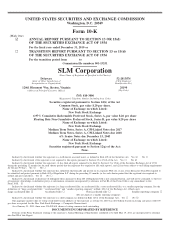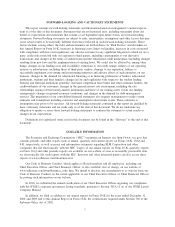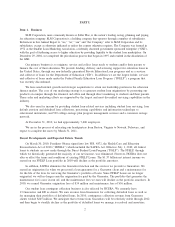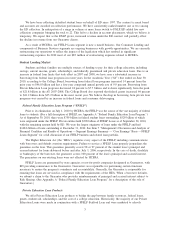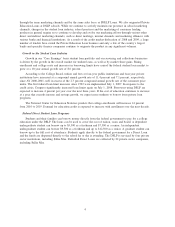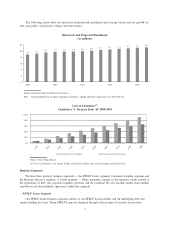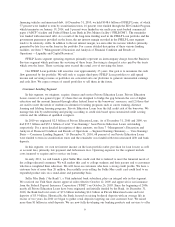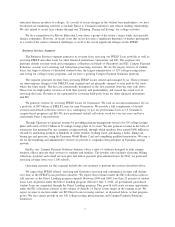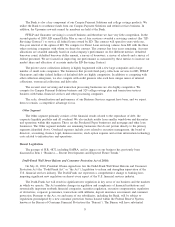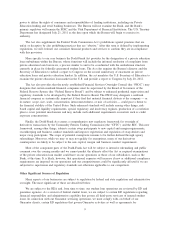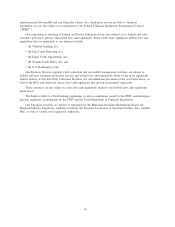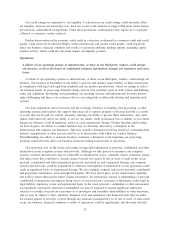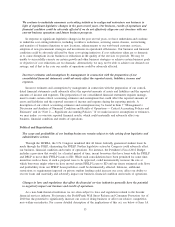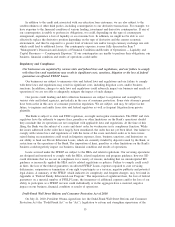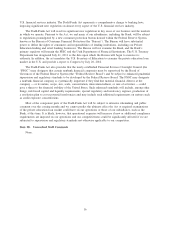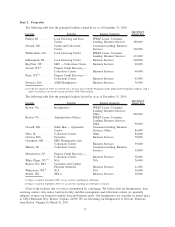Sallie Mae 2010 Annual Report Download - page 9
Download and view the complete annual report
Please find page 9 of the 2010 Sallie Mae annual report below. You can navigate through the pages in the report by either clicking on the pages listed below, or by using the keyword search tool below to find specific information within the annual report.The Bank is also a key component of our Campus Payment Solutions and college savings products. We
utilize the Bank to warehouse funds from our Campus Payment Solutions and refund services business. In
addition, the Upromise rewards earned by members are held at the Bank.
FFELP and Guarantor servicing is a runoff business and therefore we face very little competition. In the
second quarter of 2009, ED named Sallie Mae as one of four servicers awarded a servicing contract (the “ED
Servicing Contract”) to service all federal loans owned by ED. The contract will span five years with one,
five-year renewal at the option of ED. We compete for Direct Loan servicing volume from ED with the three
other servicing companies with whom we share the contract. The contract has four years remaining. Account
allocations are awarded annually based on each company’s performance on five different metrics: defaulted
borrower count, defaulted borrower dollar amount, a survey of borrowers, a survey of schools and a survey of
federal personnel. We are focused on improving our performance as measured by these metrics to increase our
market share and allocation of accounts under the ED Servicing Contract.
The private sector collections industry is highly fragmented with a few large companies and a large
number of small scale companies. The businesses that provide third-party collections services for ED, FFELP
Guarantors and other federal holders of defaulted debt are highly competitive. In addition to competing with
other collection enterprises, we also compete with credit grantors who each have unique mixes of internal
collections, outsourced collections and debt sales.
The account asset servicing and transaction processing businesses are also highly competitive. We
compete for Campus Payment Solutions business and 529 college-savings plan and transaction services
business with banks, financial services and other processing companies.
The scale, diversification and performance of our Business Services segment have been, and we expect
them to remain, a competitive advantage for us.
Other Segment
The Other segment primarily consists of the financial results related to the repurchase of debt, the
corporate liquidity portfolio and all overhead. We also include results from smaller wind-down and discontin-
ued operations within this segment. These are the Purchased Paper businesses and mortgage and other loan
businesses. The Other segment includes our remaining businesses that do not pertain directly to the primary
segments identified above. Overhead expenses include costs related to executive management, the board of
directors, accounting, finance, legal, human resources, stock option expense and certain information technology
costs related to infrastructure and operations.
Recent Legislation
The passage of H.R. 4872, including SAFRA, and its impact on our business has previously been
discussed in Item 1 “Business — Recent Developments and Expected Future Trends.”
Dodd-Frank Wall Street Reform and Consumer Protection Act of 2010).
On July 21, 2010, President Obama signed into law the Dodd-Frank Wall Street Reform and Consumer
Protection Act (the “Dodd-Frank Act” or “the Act”), legislation to reform and strengthen supervision of the
U.S. financial services industry. The Dodd-Frank Act represents a comprehensive change to banking laws,
imposing significant new regulation on almost every aspect of the U.S. financial services industry.
The Dodd-Frank Act will result in significant new regulation in key areas of our business and the markets
in which we operate. The Act mandates changes in regulation and compliance of financial institutions and
systemically important nonbank financial companies, securities regulation, executive compensation, regulation
of derivatives, corporate governance, transactions with affiliates, deposit insurance assessments and consumer
protection. Pursuant to the Act, we and many of our subsidiaries, including the Bank, will be subject to
regulations promulgated by a new consumer protection bureau housed within the Federal Reserve System,
known as the Bureau of Consumer Financial Protection (the “Bureau”). The Bureau will have substantial
8

